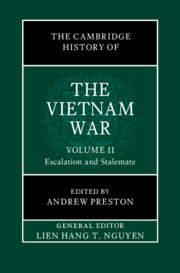Book contents
- The Cambridge History of the Vietnam War
- The Cambridge History of the Vietnam War
- The Cambridge History of the Vietnam War
- Copyright page
- Contents
- Figures
- Maps
- Tables
- Contributors to Volume II
- General Introduction
- Introduction
- Part I Battlefields
- 1 Reconsidering American Strategy in Vietnam
- 2 The Air Wars in Vietnam
- 3 US Combat Soldiers in Vietnam
- 4 American Women and the Vietnam War
- 5 The Conundrum of Pacification
- 6 The US Military Presence in South Vietnam
- 7 The ARVN Experience
- 8 The National Liberation Front
- 9 The People’s Army of Vietnam
- 10 Vietnamese Women and the War
- 11 Vietnam’s Ethnic Minorities at War
- 12 The War in Numbers
- 13 The Tet Offensive
- Part II Homefronts
- Part III Global Vietnam
- Index
8 - The National Liberation Front
from Part I - Battlefields
Published online by Cambridge University Press: 02 January 2025
- The Cambridge History of the Vietnam War
- The Cambridge History of the Vietnam War
- The Cambridge History of the Vietnam War
- Copyright page
- Contents
- Figures
- Maps
- Tables
- Contributors to Volume II
- General Introduction
- Introduction
- Part I Battlefields
- 1 Reconsidering American Strategy in Vietnam
- 2 The Air Wars in Vietnam
- 3 US Combat Soldiers in Vietnam
- 4 American Women and the Vietnam War
- 5 The Conundrum of Pacification
- 6 The US Military Presence in South Vietnam
- 7 The ARVN Experience
- 8 The National Liberation Front
- 9 The People’s Army of Vietnam
- 10 Vietnamese Women and the War
- 11 Vietnam’s Ethnic Minorities at War
- 12 The War in Numbers
- 13 The Tet Offensive
- Part II Homefronts
- Part III Global Vietnam
- Index
Summary
Few issues from the Vietnam War divided the American public more than the character and nature of the National Liberation Front (NLF). The US government claimed that communist North Vietnam controlled the NLF, and that it wanted to overthrow the government of South Vietnam by force. Antiwar scholars and activists, in sharp contrast, argued that the NLF was born in the tinder-dry rice paddies of South Vietnam in response to President Ngo Dinh Diem’s oppressive policies. The NLF was very skillful at portraying itself as local freedom fighters, organized simply to free South Vietnam from foreign domination and a corrupt Saigon government. This made it difficult for successive US presidential administrations to win support at home and abroad for their counterinsurgency programs. In reality, the NLF was both Southern and communist. The Lao Dong, the Workers’ Party of Vietnam, was a nationwide, unified movement with revolutionaries placed in most villages and hamlets throughout Vietnam. The party leadership in Hanoi included several southerners, like Le Duan – the partys general secretary – who favored armed rebellion to liberate Vietnam south of the 17th parallel and to reunify the country under the socialist banner.
Keywords
- Type
- Chapter
- Information
- The Cambridge History of the Vietnam War , pp. 174 - 188Publisher: Cambridge University PressPrint publication year: 2024

